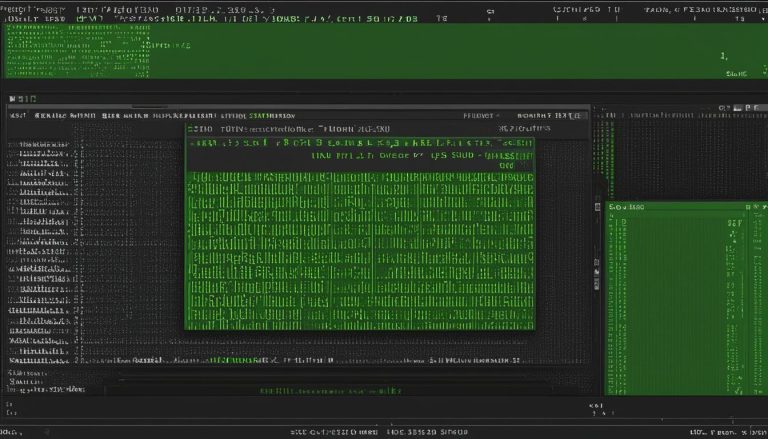Welcome to an exploration of Puppy Linux, a lightweight operating system known for its unique attributes and functionalities. In this article, I will delve into the features and benefits of Puppy Linux, as well as how to install and use it. Whether you are a tech enthusiast or someone looking to breathe new life into older hardware, Puppy Linux offers a flexible and efficient computing experience.
So, what exactly is Puppy Linux? It is an operating system designed with flexibility, user-friendliness, and efficient operability in mind. Despite its small size, Puppy Linux packs a punch with its rich features and benefits. From seamless customization to excellent performance on older hardware, Puppy Linux assures a smooth and hassle-free computing experience.
Key Takeaways:
- Puppy Linux is a lightweight operating system with unique features and benefits.
- It offers easy customization, a wide range of software applications, and excellent performance on older hardware.
- Installing and using Puppy Linux is straightforward, with a simple and intuitive user interface.
- Puppy Linux has minimal system requirements, making it ideal for older computers and devices with limited resources.
- The Puppy Linux community provides extensive support, ensuring regular updates and user-contributed documentation.
Features of Puppy Linux
Puppy Linux is a unique operating system that offers a wide range of features and benefits. Its minimalistic design sets it apart from other operating systems, making it lightweight and fast. Puppy Linux can run entirely in RAM, allowing for quick access to applications and files. This feature ensures a smooth and efficient user experience.
One of the key advantages of Puppy Linux is its high level of customization. Users can choose from various desktop environments, tailoring their system to their preferences. Whether you prefer a classic desktop layout or a more modern interface, Puppy Linux has options to suit your needs.
In addition to its flexibility and speed, Puppy Linux comes with a pre-installed set of applications. These include web browsers, word processors, multimedia players, and more. Puppy Linux also supports a wide range of file formats, allowing users to easily work with different types of documents and media files.
Puppy Linux provides excellent hardware support, ensuring compatibility with various devices. This operating system is compatible with desktops, laptops, netbooks, and even the Raspberry Pi. Whether you have an older computer or a newer device, Puppy Linux can run smoothly and efficiently.
| Feature | Benefits |
|---|---|
| Minimalistic design | Lightweight and fast performance |
| Run entirely in RAM | Quick access to applications and files |
| Customizable desktop environments | Personalize your system |
| Pre-installed applications | Ready-to-use software out of the box |
| Wide range of file format support | Easily work with different types of files |
| Excellent hardware support | Compatible with various devices |
With these features and benefits, Puppy Linux provides a reliable and efficient operating system for users looking for a lightweight alternative. Whether you’re reviving an old computer or seeking a customizable and user-friendly platform, Puppy Linux offers a seamless computing experience.
Installing and Using Puppy Linux
Installing Puppy Linux is a straightforward process that allows users to experience the benefits of this lightweight operating system. To get started, you can visit the official Puppy Linux website and download the ISO file. Once downloaded, you can create a bootable USB drive or CD/DVD using software like Rufus or Etcher. This will enable you to install Puppy Linux on your desired device.
The installation wizard will guide you through the process, allowing you to choose your preferred settings and customize your system. You can select your language, time zone, keyboard layout, and partitioning options. Puppy Linux offers a variety of installation methods, including frugal, full, or a dual-boot setup.
Once installed, Puppy Linux provides a simple and intuitive user interface, making it easy for both beginners and experienced users to navigate. The system comes with a range of pre-installed applications, including web browsers, word processors, multimedia players, and more. It also offers a comprehensive user guide and online documentation to assist users in getting started and making the most out of the operating system.
In conclusion, Puppy Linux installation is a user-friendly process that allows you to customize your system according to your needs. With its intuitive interface and extensive documentation, Puppy Linux provides a seamless experience for users of all levels. Whether you’re reviving an old device or simply looking for a lightweight and efficient operating system, Puppy Linux offers a reliable and user-friendly solution.
Puppy Linux System Requirements
Puppy Linux is renowned for its lightweight and efficient design, making it an excellent choice for users with older hardware or limited resources. To ensure optimal performance, it is essential to understand the system requirements for running Puppy Linux smoothly.
Minimum System Requirements:
| Component | Requirement |
|---|---|
| Processor | 1GHz or better |
| RAM | 1-2 GB |
Puppy Linux supports various architectures, including x86, ARM, and PowerPC, making it compatible with a wide range of devices such as desktops, laptops, netbooks, and even the Raspberry Pi. It provides seamless integration with both UEFI and legacy BIOS boot modes, ensuring compatibility with different systems.
With its minimal resource usage, Puppy Linux can breathe new life into older machines and provide a smooth computing experience. Even with modest hardware specifications, users can enjoy the benefits of a lightweight operating system with excellent performance and responsiveness.
Whether you have a low-end device or are looking for an efficient operating system, Puppy Linux offers a reliable solution. Its system requirements allow for flexibility and accessibility, making it a popular choice among users seeking a lightweight alternative to traditional operating systems.
Puppy Linux Community and Support
Puppy Linux has a vibrant community of dedicated users and developers who provide extensive support and resources for all users. Whether you are a beginner or an experienced user, the Puppy Linux community is there to assist you every step of the way.
One of the primary sources of support is the online forums, where users can ask questions, share ideas, and troubleshoot issues. These forums are a treasure trove of knowledge and experience, with community members always ready to lend a helping hand. It’s a great place to connect with like-minded individuals and learn from their expertise.
“The Puppy Linux community is one of the most welcoming and helpful communities I’ve ever come across. No matter how trivial or complex your question may be, someone is always there to guide you. It’s truly inspiring to see the level of dedication and passion shared by the members of this community.” – John, a Puppy Linux user
In addition to the forums, Puppy Linux also has active mailing lists and chat channels, providing even more avenues for community support. These channels allow for real-time interactions and direct assistance, making it easier than ever to get help when you need it.
Furthermore, the Puppy Linux community actively develops and maintains various versions of the operating system. This means regular updates, bug fixes, and new features that enhance the overall user experience. The community’s commitment to continuous improvement ensures that Puppy Linux remains a reliable and up-to-date choice for users.
Online Resources and Documentation
Aside from the community-driven support channels, Puppy Linux also offers a wealth of online resources and thorough documentation to help users make the most out of the operating system. The official website has user guides, tutorials, and FAQs that cover a wide range of topics, from installation to customization and beyond.
These resources are regularly updated and maintained, providing users with accurate and detailed information. Whether you’re a curious beginner or an advanced user looking to explore the more intricate features of Puppy Linux, the documentation is there to guide you every step of the way.
| Resource | Description |
|---|---|
| Official Forum | Connect with the community, ask questions, and share knowledge. |
| Mailing Lists | Get involved in mailing list discussions and receive updates. |
| Chat Channels | Join real-time chat channels for immediate assistance. |
| User Guides | Comprehensive guides for installation, customization, and usage. |
| Tutorials | Step-by-step tutorials for various tasks and features. |
| FAQs | Frequently asked questions and helpful answers. |
With such strong and comprehensive community support, Puppy Linux ensures that all users have the resources they need to succeed. Whether you’re a first-time user or a seasoned pro, you’ll find a helping hand and a wealth of knowledge within the Puppy Linux community.
Puppy Linux Review and Recommendations
After exploring the features and benefits of Puppy Linux, it is evident that this lightweight operating system has garnered positive reviews from both users and experts. Its exceptional performance, user-friendliness, and extensive customization options make it a noteworthy choice for individuals seeking a fast and efficient computing experience. As a reviewer, I have been impressed by the remarkable speed and low resource usage of Puppy Linux.
One of the key strengths of Puppy Linux is its ability to revive older hardware, providing a second life to computers that may have been deemed obsolete. With its minimalistic design and efficient use of resources, Puppy Linux offers a smooth and responsive interface even on low-spec machines. Users appreciate the snappy boot times and the ability to quickly access applications and files. This makes Puppy Linux an ideal option for individuals who want to extend the lifespan of their aging hardware without sacrificing performance.
“Puppy Linux is a game-changer for those with older computers. It has breathed new life into my trusty old laptop, allowing me to perform everyday tasks with ease.” – Puppy Linux user
Furthermore, the active community support surrounding Puppy Linux is commendable. The community provides extensive online forums, mailing lists, and chat channels where users can seek assistance, share experiences, and contribute to the ongoing development of the operating system. Regular updates and bug fixes ensure that Puppy Linux remains relevant and secure.
While Puppy Linux has received overwhelmingly positive feedback, there are some areas where improvements could be made. Expanding the software repository would provide users with a wider range of applications and enhance the overall user experience. Additionally, further improving hardware compatibility and expanding documentation to cater to a broader user base would be beneficial for newcomers to the operating system.
Puppy Linux Review Summary:
- Lightweight and fast performance.
- Revives older hardware.
- Efficient resource usage.
- Strong community support.
In summary, Puppy Linux lives up to its reputation as an efficient and user-friendly operating system. Its performance, customization options, and community support make it a standout choice for users looking for a lightweight alternative. With its ability to breathe new life into older hardware and its remarkable speed, Puppy Linux is a highly recommended option for individuals seeking a reliable and efficient computing experience.
Conclusion
In conclusion, Puppy Linux is a lightweight and user-friendly operating system that offers unique features and benefits. Its flexibility, efficiency, and extensive community support make it an excellent choice for users seeking a lightweight alternative to traditional operating systems.
With Puppy Linux, users can revitalize older hardware, customize their system, and enjoy a fast and secure computing experience. Whether you are a beginner or an experienced user, Puppy Linux provides a reliable and efficient platform for all your computing needs.
Puppy Linux has received positive reviews from both users and experts in the tech industry. Its lightweight nature, fast performance, and versatile features have been highlighted as major strengths. Users appreciate its ease of use and the ability to revive older hardware. They also commend the community support and the active development of the operating system.
Looking at the future, Puppy Linux could further expand its software repository, enhance hardware compatibility, and improve documentation to cater to a broader user base. These improvements will ensure Puppy Linux continues to thrive and meet the evolving needs of its users.
FAQ
What is Puppy Linux?
Puppy Linux is a lightweight operating system that offers unique attributes and functionalities.
What are the features of Puppy Linux?
Puppy Linux has a minimalistic design, runs in RAM, offers customization options, supports various file formats, and comes with a range of pre-installed applications.
How do I install and use Puppy Linux?
You can download the ISO file from the official website, create a bootable USB or CD/DVD, and follow the installation wizard’s instructions. Puppy Linux provides a simple and intuitive user interface and offers a comprehensive user guide for assistance.
What are the system requirements for Puppy Linux?
Puppy Linux requires a 1GHz processor or better and 1-2 GB of RAM. It is compatible with various architectures and can run on desktops, laptops, netbooks, and Raspberry Pi devices.
How can I get support for Puppy Linux?
Puppy Linux has a strong community of users and developers who provide support through online forums, mailing lists, and chat channels. There are also extensive online resources, tutorials, and user-contributed documentation available.
What are the reviews and recommendations for Puppy Linux?
Puppy Linux has received positive reviews for its lightweight nature, fast performance, and versatile features. Recommendations include expanding the software repository, enhancing hardware compatibility, and improving documentation.
Hi, I’m Mark, the author of Clever IT Solutions: Mastering Technology for Success. I am passionate about empowering individuals to navigate the ever-changing world of information technology. With years of experience in the industry, I have honed my skills and knowledge to share with you. At Clever IT Solutions, we are dedicated to teaching you how to tackle any IT challenge, helping you stay ahead in today’s digital world. From troubleshooting common issues to mastering complex technologies, I am here to guide you every step of the way. Join me on this journey as we unlock the secrets to IT success.


